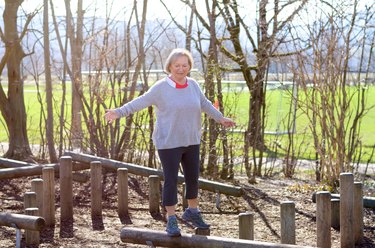
It may seem like an insignificant part of your training plan but practicing your balance is just as important as completing your cardio or doing your squats. A strong, stable foundation is necessary for pretty much all movement and can also help prevent injury.
Your ability to balance declines with age, though, and can cause you to feel more unsteady while practicing single-leg exercises or walking on uneven surfaces, according to the American Council on Exercise.
Video of the Day
Video of the Day
Balance is also affected by your day-to-day lifestyle and can become worse if you're often sitting at a desk, says Samuel Chan, physical therapist at Bespoke Treatments in New York City. Over time, this can leave you more prone to injury and may even increase your risk of falls as you get older.
If you often find yourself wobbling back and forth, struggling to stand on one leg, you may need to strengthen a few parts of your body and tweak your day-to-day lifestyle. Consider Chan's tips to help improve your balance and stay strong while standing on one leg.
If You: Feel Pain in Your Knee
You Might: Have Weak Hips and Glutes
Your gluteus medius plays a big role in your ability to balance on one leg, Chan says. This muscle runs along the side of your pelvis and is responsible for stabilizing you while you walk, run or perform any single-leg activities.
"If the gluteus medius of the standing leg is weak, it can cause the opposite hip to drop, leading to abnormal stresses up and down the entire leg, including the knee," Chan says.
Strengthening the glute medius, then, can help improve your balance and alleviate the stress placed on your standing knee. The side plank strengthens not only your gluteus medius, but the entire side of your body while building your balance. Begin with the modified side plank and work your way up to the full exercise, Chan says.
Modified Side Plank
- Lie on your side, placing your elbow down on the ground to support your upper body.
- Bend your knees and place your feet behind your body.
- Raise your hips off the ground and push them up toward the ceiling, keeping your body in a straight line.
- As you grow more comfortable with this exercise, extend your legs and balance on the sides of your feet, keeping your legs stacked and body in one line.
If You: Feel Your Ankle Wobble
You Might: Have Underdeveloped Foot Muscles
If you feel unsteady on your standing leg, your foot muscles may be a little weak. Yes, that's right, even your foot muscles matter. Poor foot or ankle control is a common issue with those struggling to stand properly on one leg, Chan says.
"Those without midfoot control can often find it difficult to maintain a tripod stance," Chan says. "This refers to the foot maintaining three points of contact with the ground: the ball of the big toe, ball of the little toe and the heel."
Incorporating more single-leg exercises (like the single-leg Romanian deadlift) in your usual workout routine can help you develop these small muscles. "Focus on keeping equal pressure between those three key points," Chan says. "Make sure not to let your arch collapse! This will ensure that all the important small stabilizing muscles in the foot are working."
Single-Leg Romanian Deadlift
- Stand with your feet about hip-width apart.
- Root your right foot into the ground with a slight bend in the knee.
- Begin to raise your left leg straight behind you, simultaneously leaning your upper body forward like a seesaw.
- Once your left leg and upper body are parallel to the ground, use your glutes and right hamstring to lower your left leg and return to standing.
- Repeat this move on the left leg.
Read more: 8 Unilateral Exercises to Challenge Your Balance
If You: Lean Too Far Forward
You Might: Have Poor Posture
Especially if you have a generally sedentary lifestyle or work at a desk for most of your day, you may have forward head posture and rounded shoulders. This may sound bad but it's actually pretty common in the general population and can affect your balance, Chan says.
"This forward posture brings your center of mass forward, pulling you outside of your base of support (at your feet)," he says. You can work on your balance by performing seated thoracic extension stretches. However, focus on bending backward at the upper back, not the lower back, Chan says.
In general, more sedentary lifestyles present mobility and balance issues and the key is to keep moving and exercise. Chan recommends supplementing your stretching with at least three 30-minute walks a week to become a little more active.
Seated Thoracic Extension
- Sit in a chair with your legs hip-width apart, feet planted on the ground.
- Place your hands behind the base of your neck, elbows up toward the sky.
- On an inhale, raise your chin and push your chest out, bending backward slightly and pulling your elbows back.
- As you exhale, return to a neutral spine, bringing your chin and neck back to neutral position.
Read more: 12 Moves for a Stronger Core and Better Posture
Was this article helpful?
150 Characters Max
0/150
Thank you for sharing!
Thank you for your feedback!